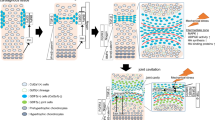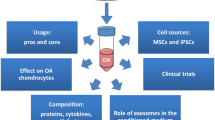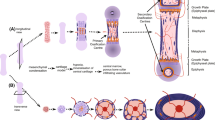Abstract
We have examined the effects of growth factor stimulation on superficial and growth zone chondrocyte populations. Zonal articular chondrocytes from 8-month-old Spanish goat distal femurs were plated in monolayer cultures and stimulated by using insulin-like growth factor I (IGF-I), basic fibroblast growth factor (bFGF), and transforming growth factor-β1 (TGF-β1). Gene expression for collagen I and II, aggrecan, and superficial zone protein were evaluated every week for 3 weeks. Finally, proteoglycan and collagen deposition were measured for each experimental group. Major differences existed in the behavior of superficial and growth zone chondrocytes, the most apparent being the higher capacity for protein synthesis by the growth zone population. Variations also existed regarding growth factor treatment. TGF-β1 had the greatest effect on proliferation over 8 days. With respect to differentiation, IGF-I increased average collagen II gene expression in the growth zone populations in comparison with growth zone controls. IGF-I increased aggrecan gene expression for the same groups. Superficial zone populations exhibited lower collagen II, collagen I, and aggrecan gene expression than the growth zone populations under all conditions. However, superficial zone protein expression was dramatically elevated in superficial zone populations by TGF-β1. Collagen I expression showed a general increase under all conditions compared with initial values. Combined biosynthesis results showed that the superficial populations secreted little to no collagen, especially collagen II, in comparison with their growth zone counterparts. Glycosaminoglycan production was also much lower than for the growth zone groups. TGF-β1 and IGF-I increased collagen II production in the growth zone populations. TGF-β1 increased glycosaminoglycan secretions in the superficial zone populations and in the growth zone populations, whereas IGF-I produced an increase in glycosaminoglycan secretion only in the growth zone populations. Thus, growth factors elicit different proliferation, gene expression, and biosynthesis responses from zonal chondrocyte subpopulations.





Similar content being viewed by others
References
Adolphe M, Froger B, Ronot X, Corvol MT, Forest N (1984) Cell multiplication and type II collagen production by rabbit articular chondrocytes cultivated in a defined medium. Exp Cell Res 155:527–536
Athanasiou KA, Shah AR, Hernandez RJ, LeBaron RG (2001) Basic science of articular cartilage repair. Clin Sports Med 20:223–247
Aydelotte MB, Kuettner KE (1988) Differences between sub-populations of cultured bovine articular chondrocytes. I. Morphology and cartilage matrix production. Connect Tissue Res 18:205–222
Benninghoff A (1925) Form und Bau der Gelenkknorpel in ihren Beziehungen zur Funktion. I. Die modellierenden und formerhalterden Faktoren des Knorpelreliefs. Z Ges Anat 76:43–63
Blunk T, Sieminski AL, Gooch KJ, Courter DL, Hollander AP, Nahir AM, Langer R, Vunjak-Novakovic G, Freed LE (2002) Differential effects of growth factors on tissue-engineered cartilage. Tissue Eng 8:73–84
Bonassar LJ, Grodzinsky AJ, Frank EH, Davila SG, Bhaktav NR, Trippel SB (2001) The effect of dynamic compression on the response of articular cartilage to insulin-like growth factor-I. J Orthop Res 19:11–17
Brittberg M, Lindahl A, Nilsson A, Ohlsson C, Isaksson O, Peterson L (1994) Treatment of deep cartilage defects in the knee with autologous chondrocyte transplantation. N Engl J Med 331:889–895
Buckwalter JA (1998) Articular cartilage: injuries and potential for healing. J Orthop Sports Phys Ther 28:192–202
Chaipinyo K, Oakes BW, Damme MP van (2002) Effects of growth factors on cell proliferation and matrix synthesis of low-density, primary bovine chondrocytes cultured in collagen I gels. J Orthop Res 20:1070–1078
Darling EM, Athanasiou KA (2003) Biomechanical strategies for articular cartilage regeneration. Ann Biomed Eng 31:1114–1124
Darling EM, Athanasiou KA (2004) Bioactive scaffold design for articular cartilage engineering. In: Moore J, Zouridakis G (eds) Biomedical technology and devices handbook. CRC, Boca Raton, pp 107–124 (Chapter 21)
Darling EM, Athanasiou KA (2005) Rapid phenotypic changes in passaged articular chondrocyte subpopulations. J Orthop Res 23:425–432
Darling EM, Hu JCY, Athanasiou KA (2004) Zonal and topographical differences in articular chondrocyte gene expression. J Orthop Res 22:1182–1187
Flannery CR, Hughes CE, Schumacher BL, Tudor D, Aydelotte MB, Kuettner KE, Caterson B (1999) Articular cartilage superficial zone protein (SZP) is homologous to megakaryocyte stimulating factor precursor and is a multifunctional proteoglycan with potential growth-promoting, cytoprotective, and lubricating properties in cartilage metabolism. Biochem Biophys Res Commun 254:535–541
Freed LE, Hollander AP, Martin I, Barry JR, Langer R, Vunjak-Novakovic G (1998) Chondrogenesis in a cell-polymer-bioreactor system. Exp Cell Res 240:58–65
Fujimoto E, Ochi M, Kato Y, Mochizuki Y, Sumen Y, Ikuta Y (1999) Beneficial effect of basic fibroblast growth factor on the repair of full-thickness defects in rabbit articular cartilage. Arch Orthop Trauma Surg 119:139–145
Guerne PA, Sublet A, Lotz M (1994) Growth factor responsiveness of human articular chondrocytes: distinct profiles in primary chondrocytes, subcultured chondrocytes, and fibroblasts. J Cell Physiol 158:476–484
Jakob M, Demarteau O, Schafer D, Hintermann B, Dick W, Heberer M, Martin I (2001) Specific growth factors during the expansion and redifferentiation of adult human articular chondrocytes enhance chondrogenesis and cartilaginous tissue formation in vitro. J Cell Biochem 81:368–377
Jin M, Emkey GR, Siparsky P, Trippel SB, Grodzinsky AJ (2003) Combined effects of dynamic tissue shear deformation and insulin-like growth factor I on chondrocyte biosynthesis in cartilage explants. Arch Biochem Biophys 414:223–231
Kim TK, Sharma B, Williams CG, Ruffner MA, Malik A, McFarland EG, Elisseeff JH (2003) Experimental model for cartilage tissue engineering to regenerate the zonal organization of articular cartilage. Osteoarthr Cartil 11:653–664
Klein TJ, Schumacher BL, Schmidt TA, Li KW, Voegtline MS, Masuda K, Thonar EJ, Sah RL (2003) Tissue engineering of stratified articular cartilage from chondrocyte subpopulations. Osteoarthr Cartil 11:595–602
Maroudas A (1979) Physicochemical properties of articular cartilage. In: Freeman M (ed) Adult articular cartilage. Pitman Medical, Tunbridge Wells, pp 215–290
Martin I, Suetterlin R, Baschong W, Heberer M, Vunjak-Novakovic G, Freed LE (2001) Enhanced cartilage tissue engineering by sequential exposure of chondrocytes to FGF-2 during 2D expansion and BMP-2 during 3D cultivation. J Cell Biochem 83:121–128
Mauck RL, Seyhan SL, Ateshian GA, Hung CT (2002) Influence of seeding density and dynamic deformational loading on the developing structure/function relationships of chondrocyte-seeded agarose hydrogels. Ann Biomed Eng 30:1046–1056
Mauck RL, Nicoll SB, Seyhan SL, Ateshian GA, Hung CT (2003) Synergistic action of growth factors and dynamic loading for articular cartilage tissue engineering. Tissue Eng 9:597–611
Mitchell N, Shepard N (1976) The resurfacing of adult rabbit articular cartilage by multiple perforations through the subchondral bone. J Bone Jt Surg Am 58:230–233
Murphy CL, Sambanis A (2001) Effect of oxygen tension and alginate encapsulation on restoration of the differentiated phenotype of passaged chondrocytes. Tissue Eng 7:791–803
Peterson L, Brittberg M, Kiviranta I, Akerlund EL, Lindahl A (2002) Autologous chondrocyte transplantation. Biomechanics and long-term durability. Am J Sports Med 30:2–12
Pfaffl MW (2001) A new mathematical model for relative quantification in real-time RT-PCR. Nucleic Acids Res 29:e45
Schinagl RM, Gurskis D, Chen AC, Sah RL (1997) Depth-dependent confined compression modulus of full-thickness bovine articular cartilage. J Orthop Res 15:499–506
Schulze-Tanzil G, de Souza P, Villegas Castrejon H, John T, Merker HJ, Scheid A, Shakibaei M (2002) Redifferentiation of dedifferentiated human chondrocytes in high-density cultures. Cell Tissue Res 308:371–379
Siczkowski M, Watt FM (1990) Subpopulations of chondrocytes from different zones of pig articular cartilage. Isolation, growth and proteoglycan synthesis in culture. J Cell Sci 97:349–360
Tew S, Redman S, Kwan A, Walker E, Khan I, Dowthwaite G, Thomson B, Archer CW (2001) Differences in repair responses between immature and mature cartilage. Clin Orthop 391 (Suppl):S142–S152
Toolan BC, Frenkel SR, Pachence JM, Yalowitz L, Alexander H (1996) Effects of growth-factor-enhanced culture on a chondrocyte-collagen implant for cartilage repair. J Biomed Mater Res 31:273–280
van der Kraan P, Vitters E, van den Berg W (1992) Differential effect of transforming growth factor beta on freshly isolated and cultured articular chondrocytes. J Rheumatol 19:140–145
Waldman SD, Grynpas MD, Pilliar RM, Kandel RA (2003) The use of specific chondrocyte populations to modulate the properties of tissue-engineered cartilage. J Orthop Res 21:132–138
Watt FM (1988) Effect of seeding density on stability of the differentiated phenotype of pig articular chondrocytes in culture. J Cell Sci 89:373–378
Williamson AK, Masuda K, Thonar EJ, Sah RL (2003) Growth of immature articular cartilage in vitro: correlated variation in tensile biomechanical and collagen network properties. Tissue Eng 9:625–634
Author information
Authors and Affiliations
Corresponding author
Rights and permissions
About this article
Cite this article
Darling, E.M., Athanasiou, K.A. Growth factor impact on articular cartilage subpopulations. Cell Tissue Res 322, 463–473 (2005). https://doi.org/10.1007/s00441-005-0020-4
Received:
Accepted:
Published:
Issue Date:
DOI: https://doi.org/10.1007/s00441-005-0020-4




